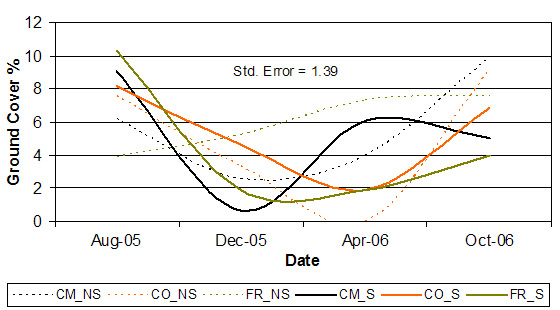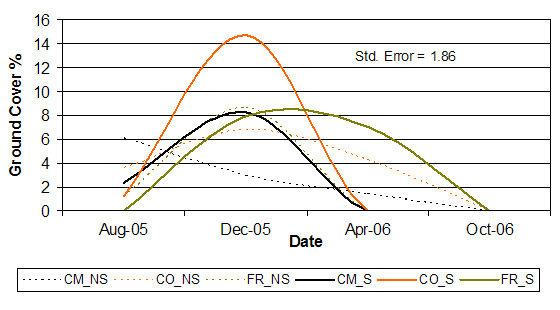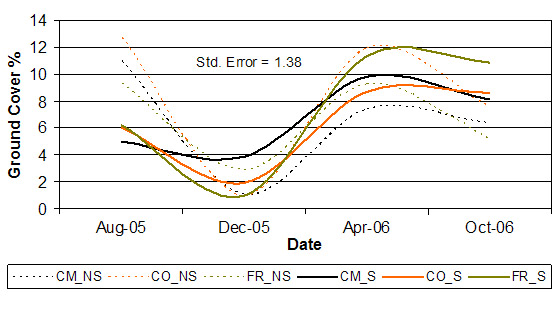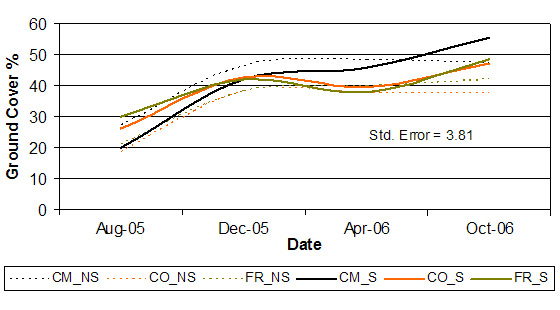TA 43 Results
Annual Forbs
The interaction Fertilizer Treatment*Seed*Time is significant at the 0.065 level. Plots receiving a seed treatment showed a decrease in the annual forb component of the plant community. On a percentage basis, there is a tendency in the no seed treatments for a higher annual forb ground cover. The compost-seed treatment shows mainly seasonal variability, and at the end of the 14-month post-treatment time, there was an indication of some decline in annual forb ground cover. At the end of 14-months, compost and control plots not receiving a seed treatment have significantly higher annual forb production than those receiving seed treatments. The lack of significance for the fertilizer-no seed treatment is attributed to the loss of nutrient efficacy from commercial fertilizers 14-months post-treatment. These results indicate that the use of NRCS recommended seed mix, with its composition of native/perennial species, effected the amount of annual forb production in the treatment plots (the establishment of perennial systems reduced the annual crop).

Figure 1. Results of multivariate analysis for fertility impacts on annual forbs 14- months post-treatment.
Annual Grasses
Annual grasses were not found in any treatment by the October, 2006 survey. The combinations compost-seed (CM_S), control-seed (CO_S), and fertilizer-no seed (FR_NS) ended with zero annual grass components in the community earlier (Apr-06) than the rest of combinations. The interaction Fertilizer Treatment*Seed*Time was significant at 0.0023 level. This anomaly is due to the interaction Fertilizer Treatment*Seed changing through time in different ways for at least two of the Fertilizer Treatment*Seed combinations. Data show no evidence of benefits for annual grasses from any of the fertilization-seed combinations. This site had a minimal annual grass population at the beginning of the trial.

Figure 2. Results of multivariate analysis for fertility impacts on annual grasses 14- months post-treatment.
Perennial Forbs
For the October 2006 analysis, perennial forbs showed significance only for the interaction "Seed*Time" at the 0.0366 level. This indicates that the effects of seeding changes over time. In August 2005, the three treatments with seed presented significantly lower perennial forb ground cover than the treatments without seed. In December 2005, the Compost/Seed treatment had the highest ground cover of perennial forbs followed by the Fertilizer/No Seed treatment. However, perennial forb species represented within this analysis were made up primarily of naturally occurring diversity with no indication of perennial forb species included in the seed mix appearing in the data transects. In April 2006, all treatment plots showed increases in perennial forb composition, but none showed statistically significant increases. It is believed that the parabolic nature of the curve is an indication of naturally occurring variation within the system and little or no influence of fertility or seeding on the perennial forb component of the community.

Figure 3. Results of multivariate analysis for fertility impacts on perennial forbs 14- months post-treatment.
Perennial Grasses
Seed effect and Fertilizer treatment effects are significant at 0.099 and 0.041, respectively, for perennial grasses. The significantly higher perennial grass cover of seeded treatments is clear at the end of the 14-month post-treatment data collection. The higher perennial grass ground cover for the compost treatment in April and October 2006 is the main reason for the significant difference between treatments. The three seeded treatments show increasing perennial grass cover trends from April to October 2006, and they suggest that may continue increasing instead of a seasonal cycle. In contrast, the non seeded treatment reached a maximum ground cover at 9-months post-treatment and remains flat for subsequent assessment periods. The consistent increase in perennial grasses treated with compost provides some indication that, for this experiment, compost may be providing a beneficial effect.

Figure 4. Results of multivariate analysis for fertility impacts on perennial grasses 14- months post-treatment.
Bareground
The effect of "Seed" shows a highly significant effect on percentage of bare ground at 0.003. Ground percentage of seeded treatments was moderately higher for fertilizer- and control-seeded plots than non seeded treatments, but all seeded treatments show a continued downward trend for bare ground, especially during the second year. In comparison, the non-seeded plots all show upward or flat trends in the bareground cover class. The combination compost-seed (CM_S) had the highest bare ground reduction for the reporting time with a decrease from 28% to 11%. The October 2006 data point shows a significantly lower bareground percent than all other treatments. The slow progression of bareground decrease reflects the time necessary for the establishment of a healthy perennial grass stand with expanding basal crowns reducing open-space between plants.

Figure 5. Results of multivariate analysis for fertility impacts on bareground 14- months post-treatment.